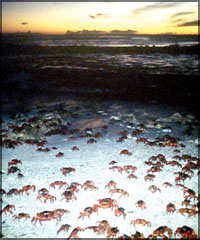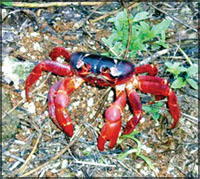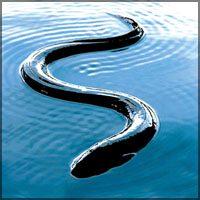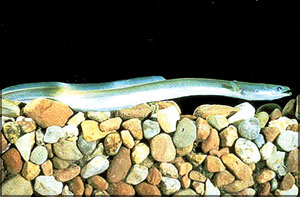|
Animal globetrotters IV
Fish, reptiles and amphibians that migrate
 After
a break of one week, due to unavoidable circumstances, we bring you
today the final article in the series After
a break of one week, due to unavoidable circumstances, we bring you
today the final article in the series
|

Red crabs
|
on the fantastic long-distance journeys made by our animal
friends. Having dealt with birds, mammals and insects, we will now
examine how and why fish, reptiles and amphibians migrate...
Many types of fish and amphibians migrate for feeding and breeding
purposes. They do so on time scales ranging from daily to annual, and
distances ranging from a few metres to thousands of kilometres.
Both freshwater and salt water fish migrate. Fish that travel between
salt water and fresh water are grouped as diadromous. Those that
live in the sea, but breed in fresh water are called anadromous.
And fish that live in fresh water and breed in sea water are
catadromous. Amphidromous fish move between fresh water and salt
water during some part of their life cycle. However, they do not migrate
for breeding purposes. Fish that migrate within fresh water only are
potamodrous and those that migrate within salt water only are
oceanodromous.
 The
most famous anadromous fish is the salmon. These fish undertake lengthy
and arduous (difficult) journeys from the ocean where they spend their
adult lives, back to their birth place, which may be fresh water streams
or rivers. The
most famous anadromous fish is the salmon. These fish undertake lengthy
and arduous (difficult) journeys from the ocean where they spend their
adult lives, back to their birth place, which may be fresh water streams
or rivers.
Some of the potamodrous fish, migrating from lake to river and back
again, include species such as barbels, catfishes, carp, minnows and
North America's garpike.
Atlantic salmon
The Atlantic salmon begins its life in a river in the wild mountain
streams of Scotland or Norway. After hatching from an egg in the spring,
it usually spends about four years in the river. Then, as an adult, it
commences its outward marathon migration.
At this stage, it is referred to as a Smolt; a young salmon,
ready to migrate to the sea. It travels down river to
|

Atlantic salmon
|
the ocean, and during this time, the smolt's physiology adapts
(changes) to enable it to live in the great ocean. Even in the ocean, it
spends four years travelling and maturing before it undertakes its
return journey as an adult salmon.
What's amazing is that it retraces its path upstream to the very
river in which it hatched about eight years ago! How does it manage to
do this, you may wonder. The salmon is able to get back to its
birthplace due to its highly developed olfactory sense. It enables the
salmon to distinguish (recognise) between different rivers purely by
scent.
Now, isn't that amazing?
The journey the salmon undertakes is not very easy. It's really a
case of 'survival of the fittest,' because in order to get to its birth
place, it not only has to swim against the tide up stream, but also leap
over waterfalls as well as all other natural and man-made obstacles.
|

Bluefin tunas
|
It is a long, exhausting journey and unless the salmon is a strong
specimen, it cannot make this journey. In fact, this migration process
helps to weed out the weakest fish and ensure that only the healthy ones
survive to pass on their genes to the next generation.
Two other species of fish that migrate are eels and tuna. But many
other species of fish too are masters of migration.
European and North American eels
Most species of eels always live in the sea, but certain species such
as the European eel, mature in fresh water and then migrate to the sea
to spawn.
The European eel begins its life in the Sargrasso Sea of the North
Atlantic. It hatches from its egg as a 10 mm long larval form known as
leptocephalus. As the larva grows larger, it drifts farther out from its
birth place,
|

Green sea turtle
|
across the Atlantic by the Gulf Stream.
It reaches the European coast three years later.Entering estuaries,
it then metamorphoses(changes) into the familiar 'glass eel' stage. It
is after this stage that the eel begins its upstream journey, not on its
own, but in vast hordes.
In its outward-bound journey seeking rivers in which to live, the eel
covers a distance of up to 5,000 km (3,100 miles). Once the eel finds
the river to settle in, it lives there for a number of years, until it
transforms into a fully mature, adult eel.
Then it is ready to make the journey downstream into the sea again,
although not much sightings of this has been recorded. However, there
are many reports of downStream journeys made by its North American
counterpart.
Once the North American eel reaches the eastern coast of North
America, it starts the final phase of its migration; it heads for the
Sargrasso Sea, where it spawns and thereby completes its life cycle. The
European eels move across the Atlantic on the Gulf Stream.
|

European eel
|
Like the salmon, the eel too is highly sensitive to olfactory
stimuli. However, it's not the only thing that helps it in its
long-distance journey, to complete its life cycle.
It uses many environmental cues to navigate, such as fluctuations in
water movements, seismic activity and also the tiniest of electrical
fields generated by water currents. During larvae stage, eels are also
helped to drift passively by ocean currents.
Bluefin tunas
As the tuna does not leave the ocean during migration, it is a
oceandramous fish. But, you may be surprised to learn that the tuna
makes a longer journey than the two masters of migration we mentioned
before; the salmon and eel. The bluefin tuna swims north from its
breeding grounds in search of prey, covering up to 10,000 km (6200
miles), sometimes.
Reptiles and amphibians
Among the reptiles and amphibians that migrate are sea turtles, frogs
and crabs. But not all their journeys are long-distance ones. For instance, frogs may migrate from one pond to
another, rarely travelling more than a couple of miles.
long-distance ones. For instance, frogs may migrate from one pond to
another, rarely travelling more than a couple of miles.
Some aquatic animals however are more adventurous and undertake
incredible journeys across entire oceans.
The sea turtles, especially the Loggerheads and Green sea turtles are
most notable among them. Loggerheads hatch in Japan and spend the next
two years swimming about 10,000 km across the Pacific Ocean to their
feeding ground in Mexico's Baja California.
After about five years, the turtles return to Japan. The Green sea
turtles that live off the coast of Brazil migrate to Ascension Island
(located off the coast of Brazil, 2,250 km away), to mate and lay eggs.
The adults later return to Brazil, leaving the young to incubate and
find their way home, alone!
|

Green sea turtle
|
One of the most abundant reptiles on Earth, are sea snakes and the
yellow-bellied sea snake is believed to migrate. Even the land crabs of
Christmas Island undertake amazing mass migration. Check out their
fantastic journeys. |
